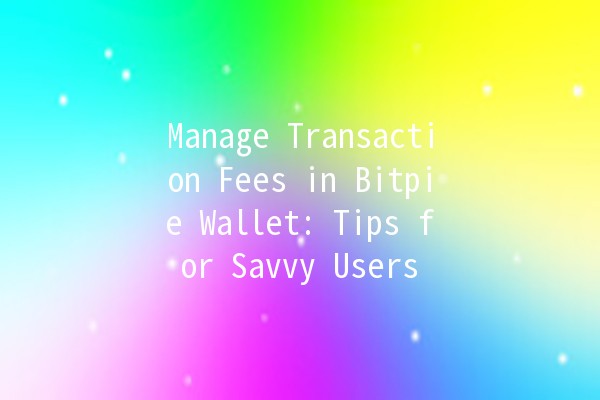
Understanding Transaction Fees in Bitpie Wallet
In the world of cryptocurrencies, managing transaction fees is an essential skill for users seeking to optimize their experience, especially for those using the Bitpie wallet. Handling these fees effectively can lead to significant savings, quicker transaction times, and a better overall cryptocurrency trading experience. In this article, we will delve deep into practical tips and techniques for managing transaction fees in Bitpie Wallet, offering valuable insights into how to use its features to your advantage.
What Are Transaction Fees?
Transaction fees refer to charges required to process transactions on a blockchain network, including those made through the Bitpie wallet. These fees can fluctuate based on network demand, the size of the transaction, and other factors. Understanding these components is crucial for users wanting to make informed decisions regarding their cryptocurrency transactions.
Tip: Always keep an eye on current network conditions.
Explanation: Transaction fees are often influenced by how busy the network is at any given time. When there are high volumes of transactions, fees tend to increase, whereas they drop during less busy times.
Example of Application: Use blockchain explorers or dedicated websites to view realtime network congestion and average fees. By waiting until the network is less congested, users can save significantly on transaction costs.

Tip: Utilize the Bitpie wallet's option to set your own transaction fees.
Explanation: Many wallets, including Bitpie, allow users to select a custom transaction fee. This feature provides flexibility, enabling users to choose a fee rate that balances speed and cost according to their needs.
Example of Application: When sending funds, users can opt for a standard fee if they’re not in a hurry or a higher fee for urgent transactions. For instance, if a user is making a nonurgent transfer, they can save money by selecting a lower fee option while waiting longer for the transaction to confirm.
Tip: Group multiple transactions into one.
Explanation: Batching allows users to send multiple transactions in one go, which can significantly reduce overall fees.
Example of Application: If you plan to send funds to several recipients, consider consolidating these into a single transaction. This not only saves on fees but can also help streamline your transaction history.
Tip: Familiarize yourself with how fees are calculated.
Explanation: Different cryptocurrencies have varying fee structures based on the transaction size, network congestion, and other factors. By knowing how fees are calculated, users can make betterinformed decisions.
Example of Application: Take Bitcoin, for instance. If you’re sending a transaction that has a large data size or is sent at peak times, fees will be higher. Understanding these elements can motivate users to use cryptocurrencies with lower fees during busy periods.
Tip: Consider using cryptocurrencies known for lower transaction fees even when using Bitpie.
Explanation: Not all cryptocurrencies have the same transaction costs. By opting for cryptocurrencies that typically charge lower fees, you can minimize transaction costs when sending or receiving funds.
Example of Application: If you frequently transfer funds but want to keep costs low, consider using cryptocurrencies like Ripple (XRP) or Stellar (XLM) in your Bitpie wallet. Both are known for having minimal transaction fees.
Additional Considerations
Beyond the five primary tips, being diligent about overall transaction strategies can help manage fees effectively.
Timing is Critical: Monitor cryptocurrency market trends, and perform transactions when prices are steady.
Choose the Right Exchanges: If trading, select exchanges with lower withdrawal fees to enhance your overall experience and manage costs better.
Stay Updated: Follow cryptocurrency news and forums to stay informed on fee trends; knowing when fees are about to rise can help users act in advance.
Common Questions About Transaction Fees in Bitpie Wallet
Transaction fees can be influenced by several factors, including network congestion, the cryptocurrency being used, transaction size, and the sender's willingness to pay a higher fee for faster processing. Understanding these elements can help users plan their transactions better.
Users can find the current average transaction fee by checking blockchain explorers specific to their cryptocurrency. Many of these explorers provide realtime information on the network's state and average fees, helping users make informed decisions.
In most cases, once a transaction is broadcast to the network, it cannot be cancelled. Users are encouraged to doublecheck transaction details, including fees, before initiating any transaction to avoid potential issues.
Transaction fees are generally variable, fluctuating based on market demand, network activity, and other factors. Users must be aware of this variability to manage their transactions effectively.
If a transaction takes too long to confirm, users may need to consider sending a new transaction with a higher fee as a priority. However, it is essential to check whether the original transaction has already completed or is pending before initiating another.
While it is challenging to predict future fees accurately, tracking historical fee trends and understanding market conditions can provide insights. Joining online communities focused on cryptocurrency can also help users stay informed about potential trends.
Managing transaction fees in the Bitpie wallet may seem daunting at first, but with the right knowledge and tools, users can significantly enhance their transactional experience. By implementing effective strategies, understanding market conditions, and utilizing the features of the wallet, users can save money, make timely transactions, and enjoy a smoother cryptocurrency experience.

